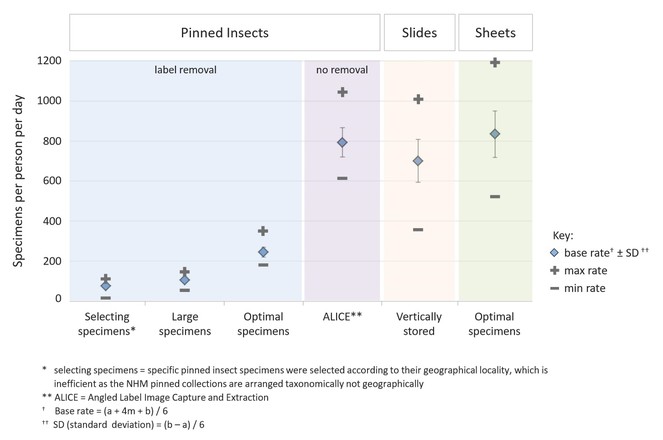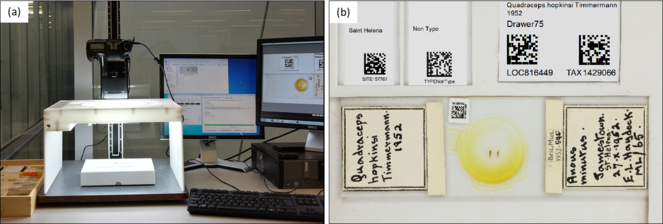|
Biodiversity Information Science and Standards : Conference Abstract
|
|
Corresponding author: Elizabeth Louise L Allan (louise.allan@nhm.ac.uk)
Received: 14 Jun 2019 | Published: 25 Jun 2019
© 2019 Elizabeth Louise Allan, Steen Dupont, Helen Hardy, Laurence Livermore, Benjamin Price, Vincent Smith
This is an open access article distributed under the terms of the Creative Commons Attribution License (CC BY 4.0), which permits unrestricted use, distribution, and reproduction in any medium, provided the original author and source are credited.
Citation: Allan E, Dupont S, Hardy H, Livermore L, Price B, Smith V (2019) High-Throughput Digitisation of Natural History Specimens. Biodiversity Information Science and Standards 3: e37337. https://doi.org/10.3897/biss.3.37337
|
|
Abstract
The Natural History Museum, London (NHM) has embarked on an ambitious Digital Collections Programme to digitise its collections. One aim of the programme has been to improve the workflows and infrastructure needed to support high-throughput digitisation and create comprehensive digital inventories of large scientific collections.
Pilot projects have been carried out for a variety of collection types, from which high-throughput imaging workflows have been developed and refined. These workflows have focused on pinned insect specimens (
The rate and time taken to digitise specimens is influenced by a number of factors that include, among others, the level of preparation and post-processing required, imaging approach, the type of specimens as well as the complexity and condition of the collection. As part of this presentation we will include information on the rate, cost and time to digitise various NHM collections, illustrating how our processes have improved digitisation efficiency and allowed us to maintain quality.
The programme has run a variety of digitisation projects, gathering data about rates of digitisation (preparation, imaging, transcription etc.) and developing improvements. Collection types such as microscope slides and herbarium sheets lend themselves to higher imaging rates, while other collections such as pinned insects, which require greater amounts of specimen handling to remove labels, tend to have lower imaging rates (Fig.
Real world imaging rates for pinned insect specimens, microscope slides and herbarium sheets for high-throughput workflows showing the impact of collection type and digitisation approach.
Another approach taken is to semi-automate mass digitisation using a combination of temporary and permanent Data Matrix barcode labels (
Imaging specimens using the multiple barcode workflow. (a) Standard imaging setup consisting of a vertically mounted DSLR camera, a custom-built lightbox and an imaging template. (b) Imaging template with a specimen (slide) and various temporary labels with metadata encoded in Data Matrix barcodes, are cropped from the final image (primary key values are used in the CMS to ensure a 1:1 match).
Keywords
automation, 2D barcodes, natural history collections, mass digitisation, pinned insect specimens, microscope slides, herbarium sheets
Presenting author
Louise Allan
Presented at
Biodiversity_Next 2019
References
-
A low cost approach to specimen level imaging of natural history microscope slides using a DSLR system.OSF Preprinthttps://doi.org/10.31219/osf.io/dvmsh
-
A novel automated mass digitisation workflow for natural history microscope slides.Biodiversity Data Journal7:e32342. https://doi.org/10.3897/bdj.7.e32342
-
No specimen left behind: industrial scale digitization of natural history collections.ZooKeys209:133‑146. https://doi.org/10.3897/zookeys.209.3178
-
iCollections methodology: workflow, results and lessons learned.Biodiversity Data Journal5:e19893. https://doi.org/10.3897/bdj.5.e19893
-
iCollections – Digitising the British and Irish butterflies in the Natural History Museum, London.Biodiversity Data Journal4:e9559. https://doi.org/10.3897/bdj.4.e9559
-
ALICE: Angled Label Image Capture and Extraction for high throughput insect specimen digitisation.OSF Preprinthttps://doi.org/10.31219/osf.io/s2p73

